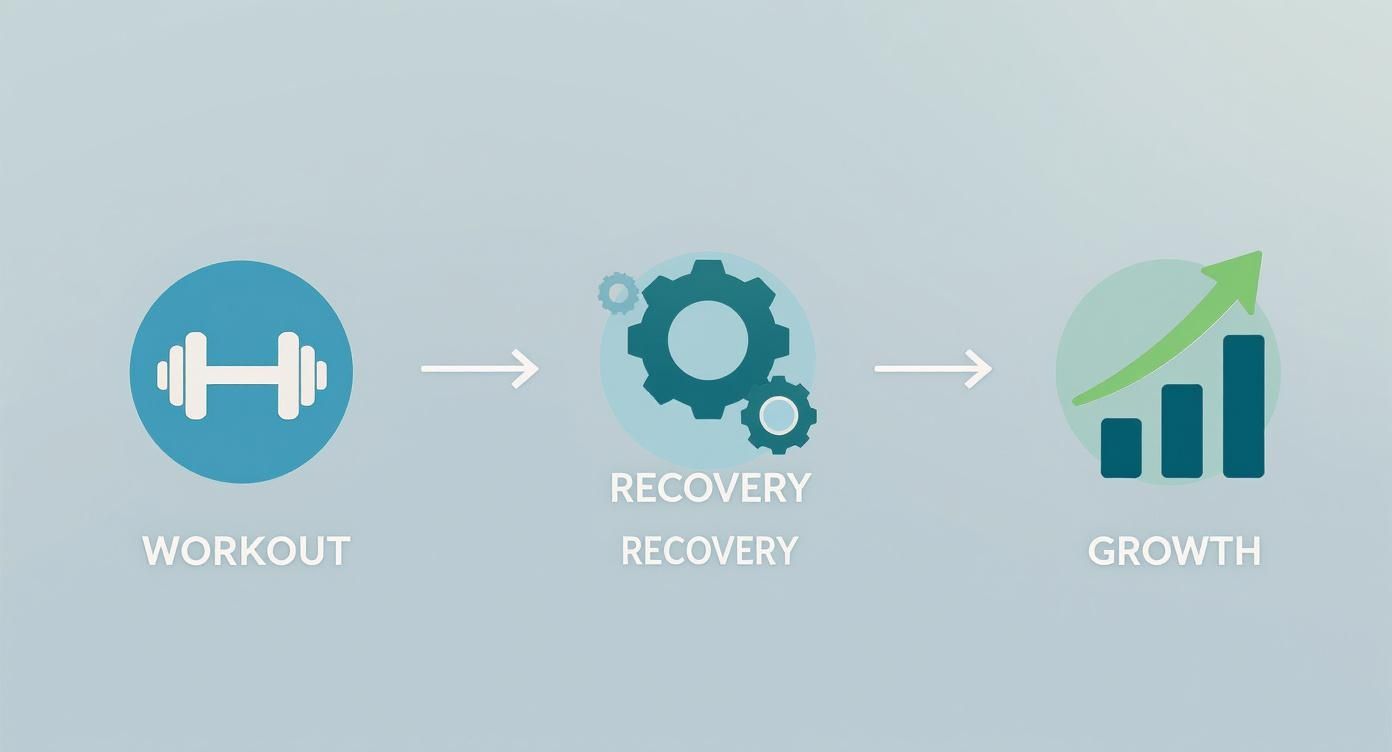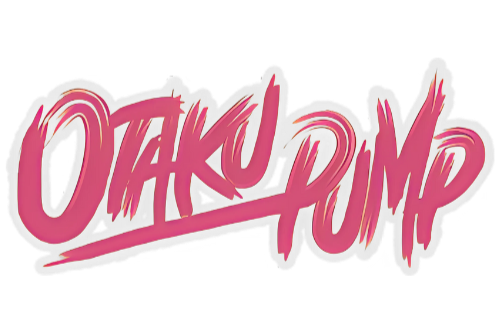When it comes to the best recovery supplements for athletes, a few key players consistently top the charts: protein powder, creatine, and amino acids (BCAAs/EAAs). Why? Because they're the most proven options for kickstarting muscle repair, dialing down soreness, and topping off your energy tanks after you've left it all on the gym floor.
Think of them as the essential raw materials your body is screaming for after being pushed to its limits. While a powerful pre-workout is key for performance, what you do afterward is what builds real strength.
Note that all claims in this article have not been evaluated by the FDA. Our products are not intended to treat or cure any diseases or conditions.
Why Your Recovery Is as Important as Your Workout
Every gut-busting workout you do is a stressor. You're literally creating microscopic tears in your muscle fibers. But the real magic—the growth, the strength gains—doesn't happen on that last, gritty rep. It happens in the hours and days that follow.
Your training session is like drawing up the architectural blueprint for a stronger, more powerful version of yourself. The recovery phase? That's the construction crew getting to work and actually building it.
It’s just like taking care of a high-performance race car. You wouldn't redline that engine lap after lap and then just park it in the garage without a second thought. You’d give it the crucial maintenance it needs to be ready for the next race. Your body is that high-performance machine. Proper, strategic recovery is what separates the dedicated from the elite, turning all that sweat and effort into real, tangible results.
The Science of Rebuilding Stronger
When you train hard, you burn through your body's fuel reserves and break down muscle tissue. The period immediately following that stress is when your body adapts and gets better. In this window, your body has three main priorities on its to-do list:
- Repair Muscle Damage: Your system goes into overdrive, rushing nutrients to those damaged muscle fibers to patch them up, making them thicker and more resilient for next time.
- Replenish Glycogen Stores: Intense exercise drains your muscles' primary fuel source, which is glycogen. A huge part of effective recovery is simply restocking those energy reserves.
- Reduce Inflammation: While a little inflammation is a normal and necessary part of the healing process, getting a handle on excessive inflammation is key to minimizing soreness and shortening the time until you're ready to go hard again.
Recovery isn't just passive downtime; it’s an active, biological process of rebuilding. Skimping on the right tools—quality nutrition, rest, and smart supplementation—is like asking that construction crew to build a skyscraper without giving them any steel or concrete.
And while a killer pre-workout from a brand like Otaku Pump is non-negotiable for crushing your training and pushing your limits, this guide is all about the critical next step. We're going to dive into how the best recovery supplements for athletes give your body the specialized tools it needs to rebuild, refuel, and come back even stronger for your next challenge.
The Pillars of Muscle Recovery: Your Core Supplement Crew
Walking into the supplement aisle can feel overwhelming. With countless bottles all screaming for your attention, how do you know what actually works? It’s easier than you think if you stop looking at them as individual products and start thinking of them as a team—a specialized crew where each member has a specific job in rebuilding your body after a brutal workout.
This isn't just about chasing hype; it's about understanding function. And it's big business. The global sports supplement market is on track to jump from $25.3 billion in 2025 to a staggering $43.6 billion by 2032. That explosion shows just how critical this stuff has become for modern athletes.
Training is a cycle. You break your body down in the gym, and then you build it back stronger. Recovery isn't just a passive waiting game; it's an active process that fuels all your future gains.

As you can see, the work you put in only pays off if you nail the recovery that follows. They're two sides of the same coin.
To give you a quick overview, let's break down the main categories of recovery supplements and what they do best.
Key Recovery Supplement Categories at a Glance
| Supplement Category | Primary Function | Best Time for Consumption |
|---|---|---|
| Protein Powders | Provides the essential building blocks (amino acids) for muscle repair and growth. | Post-workout or anytime to meet daily protein goals. |
| BCAAs/EAAs | Kicks off muscle protein synthesis and helps reduce exercise-induced soreness. | Pre-workout, intra-workout, or post-workout. |
| Creatine | Rapidly replenishes ATP (your high-intensity energy source) for improved strength and power. | Daily, often post-workout. |
| Carbohydrates | Restocks depleted muscle glycogen stores, your body's primary fuel source. | Primarily post-workout, often combined with protein. |
This table serves as a simple cheat sheet, but let's get to know the crew a little better.
Meet the Core Recovery Crew
To get the absolute most out of every single session, you need to know who’s on your team and what they do. This crew works in concert to repair, refuel, and get you ready for the next challenge.
-
Protein The Builders: Think of these as the construction workers on site. They deliver the raw materials—amino acids—needed to patch up the micro-tears in your muscles and build them back bigger and stronger.
-
BCAAs/EAAs The Expert Repair Team: If protein provides the bricks and mortar, these are the foremen. Essential amino acids signal your body to kickstart the repair process and can make a real difference in taming that post-workout muscle soreness.
-
Creatine The Energy Systems Technician: This one is all about power. Creatine's main job is to rapidly recharge your body's high-octane fuel source (ATP), making sure your energy systems are primed and ready for the next heavy lift or explosive sprint.
-
Carbohydrates The Refueling Specialists: Your muscles run on glycogen. Intense training drains those fuel tanks fast. Carbs are the specialists who come in to restock those reserves so you’re not running on empty for your next workout.
Think of your recovery strategy as a three-legged stool: nutrition, supplementation, and rest. If one leg is weak, the entire structure becomes unstable. They all work together to support your athletic goals.
Supplements are just one piece of the puzzle. Never underestimate the power of sleep. For a closer look at how crucial it is, check out the impact of sleep on muscle growth and repair. With this framework in mind, we're ready to dive deeper into each of these key players.
Protein: The Foundation of Muscle Repair
Every tough workout creates microscopic tears in your muscle fibers. This isn't a bad thing—it's actually the whole point. This damage is the trigger that tells your body it's time to rebuild, and to do that, it needs the right raw materials. Protein provides those essential building blocks, called amino acids, to patch up the damage and build your muscles back even stronger than before.
Think of it like a blacksmith forging a sword. The intense heat and hammering (your workout) breaks down the metal. Then, the blacksmith (your body) reinforces it with new material (protein) to create a stronger, more resilient blade. This repair process is how all that effort in the gym actually turns into visible progress.
This whole cycle is known as muscle protein synthesis, and it’s the absolute cornerstone of athletic recovery. When you give your body a high-quality protein source right after a workout, you’re delivering exactly what it needs to get to work immediately. Skimp on protein, and your body can't repair itself properly, which can lead to stalled results and that lingering soreness we all hate.
Choosing Your Protein Source
Not all protein is created equal, especially when you factor in timing and how quickly your body can use it. Different types have different jobs, so understanding the players helps you build a smarter recovery strategy.
Here are the most common options:
- Whey Protein: This is the undisputed champ of post-workout recovery. Because it’s derived from milk, whey digests incredibly fast, rushing amino acids straight to your muscles when they're screaming for them. This makes it perfect for that 30-60 minute "anabolic window" after training. A standard scoop usually packs around 25 grams of pure, high-quality protein.
- Casein Protein: The other side of the milk protein coin. Casein is whey's slow-and-steady cousin. It forms a gel-like substance in your stomach, leading to a sustained, trickle-feed of amino acids over several hours. It’s an absolute game-changer taken before bed, fueling muscle repair all night long.
- Plant-Based Proteins: Options like pea, rice, and soy protein are fantastic for vegan athletes or anyone with dairy issues. Modern blends are expertly formulated, often combining multiple sources to create a complete amino acid profile that rivals whey.
How Much Protein Do You Really Need?
Nailing your daily protein intake is non-negotiable for real recovery and growth. The right amount depends on your weight, activity level, and goals. For a deep dive into supplement strategy, check out our guide on the best supplements for lean muscle.
As a solid rule of thumb, active people looking to build muscle should aim for 1.2 to 2.0 grams of protein per kilogram of body weight each day. This gives you enough raw material to not only bounce back from tough sessions but to actually build new, stronger muscle tissue.
Don't just cram it all in at once. Spreading your intake throughout the day keeps that muscle protein synthesis engine running consistently. By using the right protein sources at the right times and hitting your daily target, you’re giving your body the foundation it needs to turn all that hard work into powerful results.
BCAAs and EAAs: The Specialized Repair Crew
If protein powder is the truckload of raw materials arriving at your muscle-building site, think of Branched-Chain Amino Acids (BCAAs) and Essential Amino Acids (EAAs) as the specialized crew chiefs. They don't just dump the bricks; they direct the entire repair process.
These aminos play a much more targeted role. They act as potent signalers, essentially yelling at your body to kickstart muscle protein synthesis—the fundamental process of rebuilding stronger, more resilient tissue. This direct action makes them one of the best recovery tools for any athlete trying to slash downtime.
They’re not just builders, either. They’re protectors. Taking them around your workout can actually reduce how much muscle gets broken down in the first place, helping you stay ahead of the recovery curve before you’ve even un-racked your last set.
BCAAs vs. A Full EAA Profile
For a long time, BCAAs—leucine, isoleucine, and valine—were the kings of the amino world. Leucine, in particular, is the MVP, acting as the primary trigger that gets the whole muscle-building engine started.
But here’s the thing: having only those three aminos is like having the crew chief show up to the job site alone. He can shout the orders, but without the rest of the workers, not much is getting built.
This is where a complete Essential Amino Acid (EAA) profile changes the game. EAAs provide all nine essential amino acids your body can't make on its own, which includes the three BCAAs.
Think of it like this: BCAAs flip the "on" switch for muscle repair, but a full EAA supplement provides all the nuts, bolts, and gears for the machinery to actually run. For serious recovery, a complete EAA profile is far superior because it supplies everything needed for the job.
Supplementing with a full spectrum of EAAs ensures your body has every single building block required to repair and grow effectively. For a deeper dive, check out our complete guide to amino acids for muscle recovery.
The Role of Aminos in Pre-Workouts
While most people think of aminos as a post-workout recovery aid, there's a reason you'll find them in high-quality pre-workouts, like those from Otaku Pump. It's a strategic move.
Sipping on aminos during your workout helps fight muscle fatigue and breakdown from the very first rep. By giving your muscles a readily available fuel source, you help preserve that hard-earned tissue and reduce the amount of damage control you have to do later. It’s a proactive approach that leads to a faster, more efficient recovery.
Refueling Your Energy with Creatine and Carbs
Rebuilding muscle is only half the battle. If you want to show up even stronger for your next session, you have to restock your energy reserves—and that's where creatine and carbohydrates come in. They're the one-two punch for refueling your body's engine.

Imagine your muscles have a tiny, super-fast battery for explosive movements like a heavy squat or a dead sprint. That battery is called ATP (adenosine triphosphate). When you go all-out, you drain it almost instantly. Creatine is like a rapid-recharging station for that battery, helping you regenerate ATP so you can grind out those extra reps.
It's one of the most studied and proven supplements on the planet for a reason. It directly fuels your ability to generate power, rep after rep and workout after workout.
Creatine: The High-Speed Energy Technician
Many high-quality pre-workouts include creatine because its primary job is to fuel performance. However, its real magic happens during recovery. By supplementing with it consistently, you keep your ATP reserves topped off, meaning your muscles are always primed with high-intensity fuel. This is what leads to real strength gains and faster recovery between sets and sessions.
It’s no surprise that the global market for muscle recovery supplements is booming. This corner of the sports nutrition world is expected to be worth around $695 million in 2025 and is projected to grow at a steady 6.9% each year through 2033. For a closer look at what's driving this growth, check out the analysis from Data Insights Market.
And if you want to get into the nitty-gritty of how it works, you can learn more about what creatine monohydrate is and why it’s so effective.
Carbohydrates: Restocking Your Primary Fuel Tank
If creatine handles the short-burst, explosive energy, then carbs manage your main fuel tank. During any tough workout, your body chews through its stored carbohydrates, known as muscle glycogen. Trying to train without replenishing that glycogen is like trying to drive a car on fumes—you’re not going to get very far.
This is why post-workout carbs are non-negotiable for serious athletes. They are essential for refilling your glycogen stores and ensuring you have the endurance you need for whatever you're tackling next.
The real secret is combining carbohydrates with a fast-acting protein source right after you train. The carbs spike insulin, which acts like a key, unlocking your muscle cells to shuttle in both glucose (from the carbs) and amino acids (from the protein) more efficiently. This tag-team approach accelerates both refueling and repair.
This is easily one of the most powerful and simple strategies for kickstarting your recovery. A quick post-workout shake with whey protein and a carb source like maltodextrin or even just a banana can get the job done. By focusing on both creatine and carbs, you’re not just patching up muscle damage—you're making sure your energy systems are fully reloaded and ready to go.
How to Build Your Personal Recovery Stack
Alright, let's put this all together. Building your own recovery stack isn't about just grabbing a bunch of tubs off the shelf and hoping for the best. It’s about creating a smart, targeted strategy that lines up perfectly with your training goals. A good stack gives you exactly what you need without burning a hole in your wallet for things you don't.
Believe it or not, the process actually starts before you even finish your workout. A solid pre-workout, like the ones from Otaku Pump, doesn't just get you amped up for a big session; the amino acids and creatine in our formulas help reduce muscle breakdown from the get-go. This sets the stage for a much smoother recovery later on, making your post-workout efforts even more effective.
The sports nutrition market is blowing up—it was valued at around $27.3 billion in 2025 and is on track to smash $60 billion by 2035. That's great because it means more innovation, but it also means a lot more noise to cut through when you're trying to figure out what works.
Stacks for Different Athlete Archetypes
The way you train completely dictates what your body needs to recover. A powerlifter’s stack is going to look way different from a marathon runner’s, simply because the demands on their bodies are worlds apart.
Here are a couple of examples to get you thinking:
-
The Powerlifter/Strength Athlete: The name of the game is muscle repair and pure strength gains.
- Pre-Workout: A formula from Otaku Pump to maximize power output and focus under the bar.
- Post-Workout: A fast-absorbing whey protein shake to immediately kickstart muscle protein synthesis.
- Daily: A consistent intake of creatine, which is already in your Otaku Pump pre-workout, keeps your ATP stores topped off for those explosive, heavy lifts.
-
The Endurance Athlete (Runner, Cyclist): The focus here is all about refueling glycogen stores and fighting off that deep muscle soreness.
- Pre-Workout: Otaku Pump's formula provides the energy and focus needed for long sessions, while its amino acids help preserve muscle tissue.
- Post-Workout: A shake with a 2:1 or 3:1 carb-to-protein ratio is ideal for rapidly replenishing spent energy.
- Daily: Electrolytes are non-negotiable to replace all the essential minerals lost through sweat.
Think of your personal stack as an evolving toolkit. As your training shifts, your recovery strategy needs to shift with it. Pay attention to how your body feels, track what's working, and don't be afraid to adjust your supplements to match your current goals.
Building an effective stack is a game of precision. To get a broader look at what else is out there, check out these top supplements athletes should consider for performance and longevity. By taking the time to really assess your needs, you can build a cost-effective protocol that delivers real, measurable results.
Your Top Recovery Supplement Questions Answered
Stepping into the world of recovery supplements can feel a bit overwhelming. Let's clear up some of the most common questions so you can build your recovery plan with confidence and know you're making the right moves.
If I Eat a Healthy Diet, Do I Really Need Supplements?
A solid diet is your foundation—that part is non-negotiable. But even the best meal plan can't always match the strategic advantage of a well-formulated recovery supplement. They’re designed to deliver targeted, fast-absorbing nutrients right when your body needs them most.
Think of it this way: a supplement gives your muscles the key nutrients they're screaming for immediately after a workout. It can kickstart muscle repair with precise doses of protein and amino acids way faster than a whole food meal, which needs time to digest and break down. While a good pre-workout can kickstart this process, post-workout supplements are for maximizing the repair window.
What’s the Best Time to Take Recovery Supplements?
For the biggest impact, aim for the 30-60 minute "anabolic window" right after your workout. This is when your muscles are like sponges, primed to soak up nutrients for repair and growth. A shake with fast-digesting protein and carbs is perfect for this.
But here’s the real secret: consistency is king. While timing that post-workout shake gives you an edge, hitting your total daily nutrient goals every single day is what truly builds lasting strength and endurance over time.
Your post-workout supplement is a powerful tool, but your overall daily intake is the master plan. Focus on consistency first, then optimize the timing.
Are Recovery Supplements Just for Bodybuilders?
Not at all. Any athlete pushing their limits can see huge benefits from a smart recovery strategy. The science is the same whether you're a runner, a CrossFitter, or a weekend warrior. Intense training breaks down muscle, and proper recovery builds it back stronger.
Recovery supplements are for anyone who wants to slash muscle soreness, speed up tissue repair, and bounce back faster. This lets you get back to training sooner and with more intensity, no matter what your sport is.
Ready to prime your body for peak performance and set the stage for a faster recovery? Otaku Pump delivers the anime-inspired energy you need to crush your workouts and start the rebuilding process right. Check out our pre-workout formulas at https://otakupump.com.




